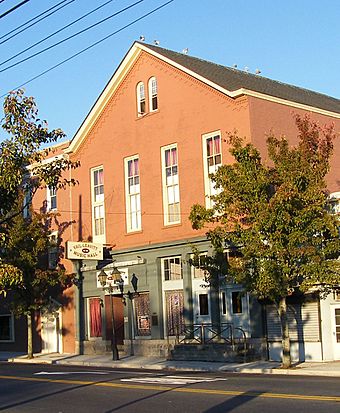Vail-Leavitt Music Hall facts for kids
Quick facts for kids |
|
|
Vail-Leavitt Music Hall
|
|

Vail-Leavitt Music Hall
|
|
| Location | 18 Peconic Avenue, Riverhead, Suffolk County, New York, US |
|---|---|
| Built | 1881 |
| Architect | David F. Vail, George M. Vail |
| Architectural style | Beaux-Arts |
| NRHP reference No. | 83001809 |
| Added to NRHP | August 25, 1983 |
The Vail-Leavitt Music Hall is a historic theater located in Riverhead, on the east end of Long Island. This special building was constructed in 1881 and has been a part of the community for a very long time. Today, it continues to be a place for many different events.
Contents
A Look Back at the Music Hall's History
The Vail-Leavitt Music Hall was built by David F. Vail, a local lumber dealer. His son, George M. Vail, helped him create this important building.
Opening Day and Early Features
The theater first opened its doors on October 11, 1881. It was designed to be like a small opera house, with a main theater and a balcony upstairs. The ground floor of the building had shops for businesses.
When it first opened, the music hall was lit by candles. Soon after, the Vail family started a gas plant behind the theater. This allowed them to install gas lights all around the horseshoe-shaped balcony. Gas lighting was used until July 1888, when the building got modern electric lights.
New Owners and Exciting Inventions
In 1908, George M. Vail, who now owned the Music Hall, sold it to Simon Leavitt. Simon was a tailor and clothier. He rented out the upstairs theater space for shows.
A few years later, in 1914, something very cool happened at the Music Hall. The famous inventor Thomas Edison used the venue to show off his new invention called the kinetophone. This was an early attempt to make movies with sound, trying to match the sound to the moving pictures.
Changes Over the Years
As time went on, newer and more modern theaters were built in the area. The Vail-Leavitt Music Hall changed its purpose many times. It was used as a restaurant, a roller skating rink, and even a place for betting. Even with all these changes, the balcony and the stage area stayed mostly the same.
Eventually, Simon Leavitt's son, Theodore Leavitt, took over the family's clothing business. He closed the upstairs theater and used it for storage until he retired in the 1970s.
Bringing the Music Hall Back to Life
After Theodore Leavitt passed away, his wife, Mollie Leavitt, owned the music hall. In 1982, a group called the Council for the Vail-Leavitt Music Hall bought the building. They received a special grant to help them. This Council is a non-profit organization that now manages and runs the theater.
From the early 1980s to the late 1990s, old movies were shown in a small space downstairs called the "Mini-Cine." Showing these movies helped raise money to restore the music hall. Because of its historical importance, the theater was added to the National Register of Historic Places on August 25, 1983.
The Vail-Leavitt Music Hall had its grand re-opening on June 28, 2003. Today, it is a busy place that hosts many cultural, community, and charity events throughout the year. It has about 300 seats, including the balcony, and is known for its beautiful Beaux-Arts style. It is an independent theater that focuses on live stage performances.



